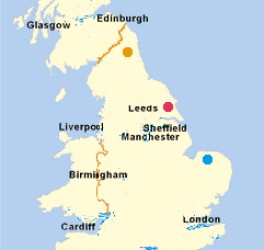
It's fine for me to claim that the Wighton name originated in England and that our family emigrated from England to Scotland at some point in history. But, when might we have done that? After all, England and Scotland were at war with each other for most of the middle ages. Shifts in population between warring countries just don't happen. In addition, in those days, peasant classes were tied to the land they farmed - they couldn't just pick up and leave. So, if I am to assert with reasonable confidence that the Wightons moved from England to Scotland, I have to explain those contradictions.
The story starts with the Norman conquest of England in 1066. William the Conqueror and his army quickly defeated the Anglo Saxon armies and began installing the feudal system in England. Following the conquest, the Scottish monarchy intermarried with the Anglo-Saxon monarchy who had fled England. They probably kept a close watch on events in England - there would be the concern that the Normans might cast an eye north. A half-century later, one of Scotland's most effective kings would take a leaf from the Norman book and apply it to Scotland.
Impressed by the governmental and cultural innovations introduced in England by the Normans, King David I (1124-53) decided that Scotland could benefit from what they could provide. He promised large tracts of land and entry into Scottish nobility for those Anglo-Norman families who would swear allegiance to him. (Historians refer to the Normans living in England after 1066 as Anglo-Normans after the dialect of Old French language (Anglo-Norman) that they spoke.) King David's offer attracted many of the Anglo-Norman families who, together with their retinues of dependents, emigrated to Scotland.
From David's perspective, what he wanted from the Anglo-Normans was a fierce fighting machine. Since he was constantly having to deal with competitors to his throne, the allure of a strong set of nobles who would be loyal to the crown and who could pacify troublesome Scottish lairds was too much to ignore. The Anglo-Normans quickly installed the feudal system through which all Scots paid liege to some higher official. Land ownership was the key - he who held the most land and had the most people resident on those lands (and paying fees, tithes, taxes, tribute) was the most powerful. Power was exercised by building castles which could dominate everyone in the neighbourhood. In those areas that were particularly troublesome (i.e., the Highlands), the Scottish king led armies of Anglo-Norman nobles on pacification trips. The king would then deed large tracts of lands to a local lord who, in return for acknowledging his loyalty to his king (and paying tribute, raising armies when necessary), would maintain the king's peace in the area (i.e. by subduing the neighbouring clans).
The flow of people north to Scotland was not restricted to just nobles and their retinues. King David was making changes in trade and commerce as well. He established chartered burghs throughout the regions. All forms of commerce were banned outside these burghs. Royal Burghs were given the exclusive right to trade with foreign merchants. This preferential treatment brought traders and valuable craftsmen from Flanders, Northern France, and England to the burghs where they eventually settled. Thus, there were two reasons for a migration north - aristocratic and commercial. Both Barrow (1980) and Davies (1990) have characterized the Anglo Norman era as a wave of colonization.
Here are some quotes from their books that will demonstrate why this element to the Anglo-Norman era is important to Wighton families. The Anglo Norman penetration ... was not merely an aristocratic affair; it was vitally underpinned by considerable popular migration. (Davies, p. 8). From Barrow, we read: Much of the settlement was at the unchronicled level of new bourgeoisie and servant class,... merchants, craftsmen, servants, and scriveners. (Barrow, p. 30)
Where did these commoner immigrants go? In talking about the Royal Burghs and the growth they enjoyed after receiving a charter, Davies (p. 8) wrote: Historians are agreed that the population of these early Scottish towns came overwhelmingly from England, especially eastern England. Barrow wrote (p. 30): Incomers from the south [were found] in almost every parish of southern Scotland. [They had] fairly extensive settlements in ... Fife, ... Angus.
From how far away did immigrants come? Davies was quite vague, for example: The external migration from Northumberland, Yorkshire, and further south into hitherto Celtic speaking districts... greatly reinforced the Middle English elements in Scots speech. (p. 14). Barrow provided a much more helpful description. In his description of the Stewart family who would become monarchs, he commented that about a hundred vassals, tenants and other dependents from the village of Palgrave accompanied the Stewarts north. Palgrave is in the approximate center of Norfolk.
